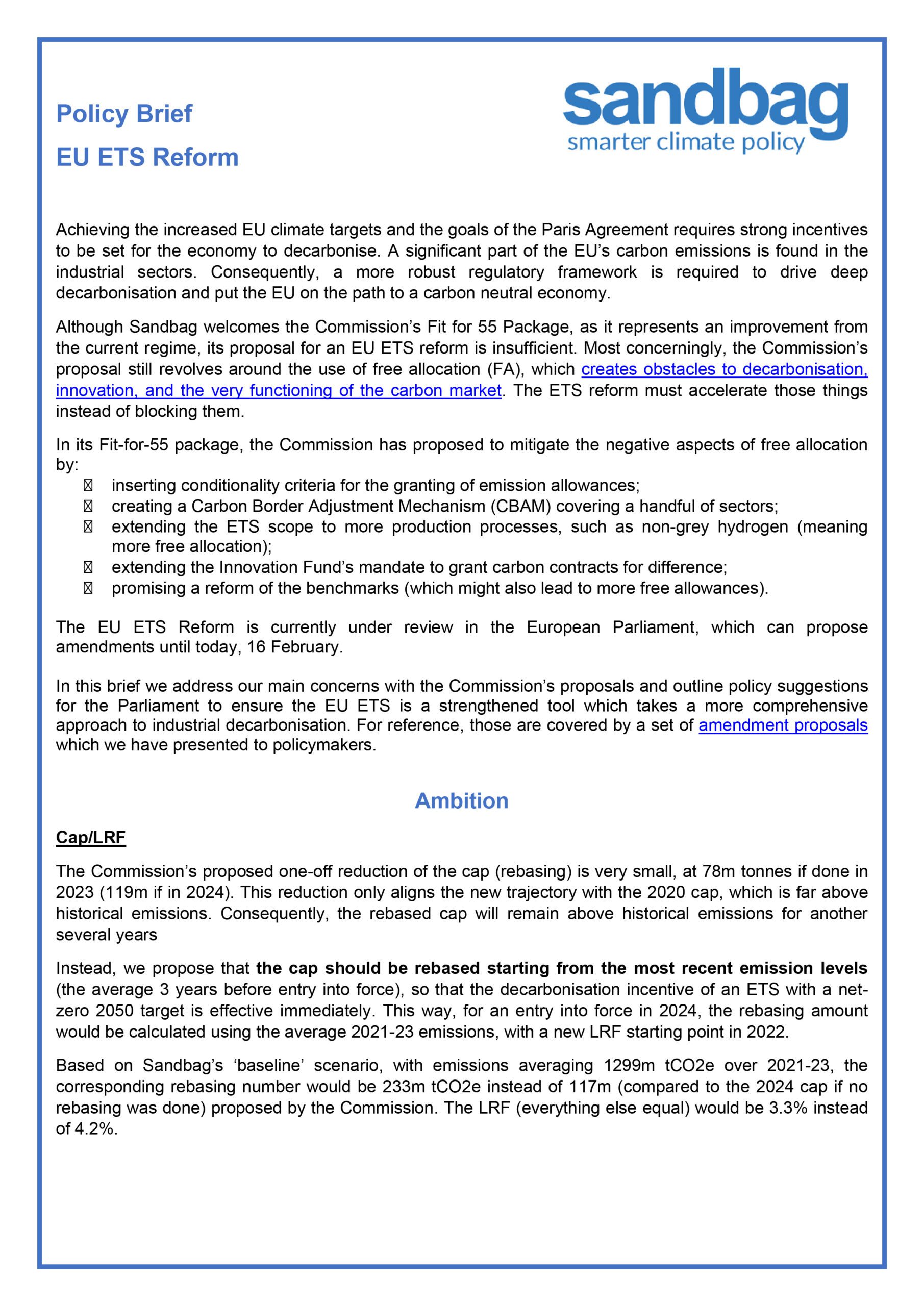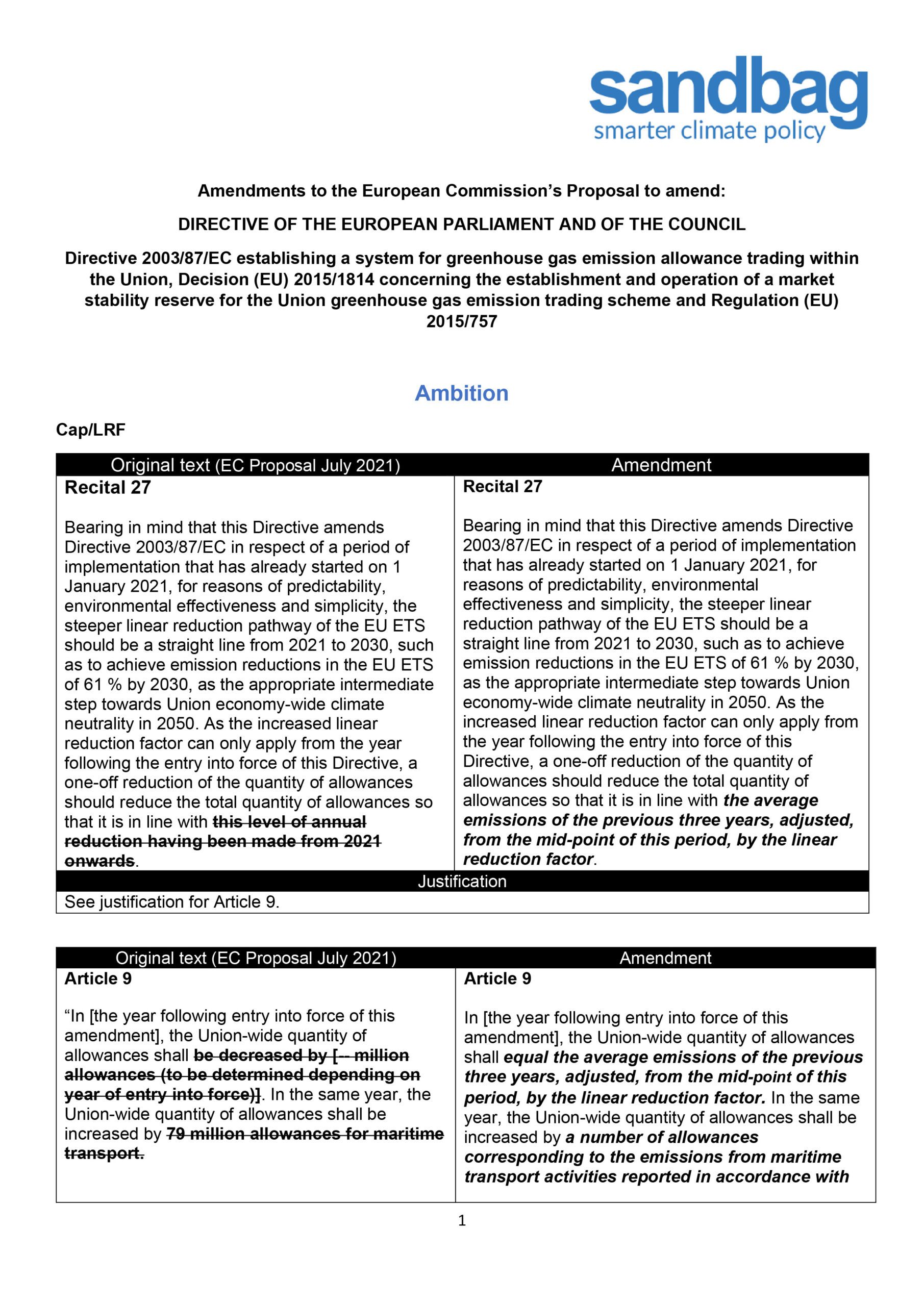EU ETS Reform - Policy Suggestions for the European Parliament
Achieving the increased EU climate targets and the goals of the Paris Agreement requires strong incentives to be set for the economy to decarbonise. A significant part of the EU’s carbon emissions is found in the industrial sectors. Consequently, a more robust regulatory framework is required to drive deep decarbonisation and put the EU on the path to a carbon neutral economy.
Although Sandbag welcomes the Commission’s Fit for 55 Package, as it represents an improvement from the current regime, its proposal for an EU ETS reform is insufficient. Most concerningly, the Commission’s proposal still revolves around the use of free allocation, which creates obstacles to decarbonisation, innovation, and the very functioning of the carbon market. The ETS reform must accelerate those things instead of blocking them.
In its Fit for 55 package, the Commission has proposed to mitigate the negative aspects of free allocation by:
- inserting conditionality criteria for the granting of emission allowances;
- creating a Carbon Border Adjustment Mechanism (CBAM) covering a handful of sectors;
- extending the ETS scope to more production processes, such as non-grey hydrogen (meaning more free allocation);
- extending the Innovation Fund’s mandate to grant carbon contracts for difference;
- promising a reform of the benchmarks (which might also lead to more free allowances).
In the Policy brief we address our main concerns with the Commission’s proposals and outline policy suggestions for the Parliament to ensure the EU ETS is a strengthened tool which takes a more comprehensive approach to industrial decarbonisation. This is also covered by a set of amendment proposals which we have presented to policymakers.
Summary of Policy Suggestions
To summarise, we propose the following policy suggestions for the EU ETS reform:
- CAP/LRF – rebase the cap starting from the most recent emissions levels (the average 3 years before entry into force, e.g. 2021-23) for entry into force in 2024 the rebasing amount would be calculated using the average 2021-23 emissions, with a new LRF starting point in 2022.
- ETS2 – no MSR with initial endowment.
- MSR Decision – reduce the MSR thresholds to zero and 100 million for low and high, respectively.
- Control of supply of allowances – only allow the release of allowance from MSR and NER if the previous year’s emissions did not exceed the cap.
- Member States – allow to use ETS money to support circularity and skill formation in line with the need to adjust professional practices to circularity and the use of low-carbon materials.
- Innovation Fund – Rename and refocus on environmental impact rather than innovation: 1) For projects, restrict eligibility to deep decarbonisation and drop the obligation for innovation; 2) Open up to measures not based on individual projects, to support circularity, and programmes of support at EU level.
- Modernisation Fund – improve channels of spending the funds before increasing the size; increase to 100% the share of priority investments.
- Free allocation – avoid wherever possible and only used if 1) there is a reassessed carbon leakage risk, 2) there is a lack of identified substitute products or circularity measures, 3) alternatives to free allocation (incl. CBAM) are unsuitable.
- Reform of the benchmarks – The benchmarks must be reviewed sooner than is proposed (before the period from 2026 to 2030) as there could be several aspects to review once it is in force and leaving it any later will risk loopholes making their way into the system, thus weakening the effectiveness of this measure. Further, the review must account for other available measures, such as assessing if the product could be substituted, and the circular use of materials to increase resource efficiency.
- CBAM – immediately phase-in products for which the carbon content of products manufactured by large international competitors is not significantly lower than in the EU, speed of phasing in based on the readiness of EU manufacturers to transition to lower carbon production, with longstop date of 2028.
- Scope – do not extend to all hydrogen production; include municipal waste incineration installations as of 2024.
- Article 29a – In case of excessive price fluctuations, do not release allowances from the Market Stability Reserve, or from the New Entrants Reserve 320m initial endowment.
Photo by Guillaume Périgois on Unsplash


